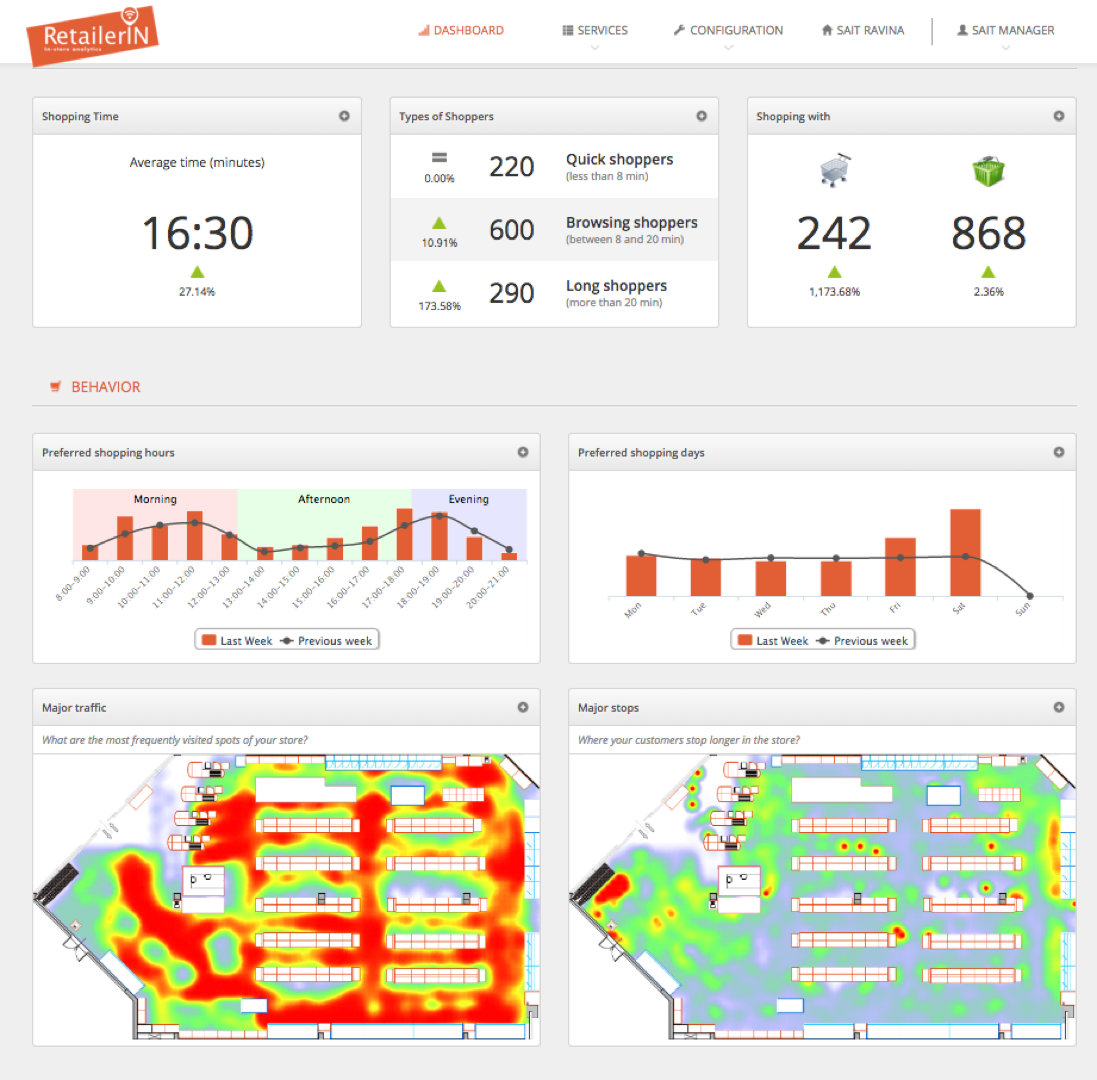IoT: Smart Indoor Spaces with a Purpose
According to a study by the US Environmental Protection Agency we spend approximately 93% of our time indoors [1]. It is not surprising that over the last two decades significant efforts have been spent on developing information and communication technology aimed at making such environments better able to respond to our needs [2]. The approaches proposed were very diverse, to take account of the diversity in indoor spaces (Home, Office, Hospital, Factory, Car) and in the resulting use cases. Initiatives around the concept of smart spaces flourished, leading to a large body of scientific publications, demonstrators and prototypes.
Yet, if we look at the current situation from a layman's perspective, it is nothing but disappointing. While for 7% of our time we have a number of effective and very popular services making our life easier when travelling, commuting or doing outdoor activities (mapping services, navigation services, geo-based search engines, proximity dating, etc.), what do we have for the remaining 93% of our life?
The Internet of Things (IoT) holds the promise of enabling indoor environments to become 'truly' smart spaces by connecting devices and objects to the internet. Yet, will this suffice?
Making indoor spaces smart: key enablers
The first point to understand is whether the necessary enabling technology is actually there. Although IoT is a rapidly moving field, with advances in electronics, communications and computing pushing the frontier forward on a monthly (if not weekly) basis, there is still in our opinion one big open issue for building truly smart spaces: indoor localisation.
Indoor localisation is the entry gate to the field of indoor location-based services. This can find a number of applications in various scenarios, covering both B2C services (e.g. navigation in shopping malls or hospitals) as well as B2B ones (e.g. security and safety of personnel in hazardous environments, real-time pinpointing of portable medical equipment in health and care facilities). The ability to detect the position of assets and people with 'sufficient' accuracy and precision represents one of the key missing bricks (we would dare to say the missing brick) for building indoor smart spaces [3].
Indoor positioning: where do we stand?
Indoor localisation is a well-studied field (an IEEE Xplore search returns an astonishing 4,294 results), yet no silver bullet exists [4]. Different solutions have been proposed, mostly based on wireless communication technologies (WiFi, Bluetooth Low-Energy, ZigBee, UWB) and making use of different techniques for mapping wireless signal features to distance and position (received signal strength indicator-based methods, time-of-arrival, direction-of-arrival). An alternative method which has gained traction in some domains is based on the usage of computer vision techniques to detect entities through cameras and infer their position in space.
WiFi (both active and passive radar-like approaches [5]) and beacon technologies are already sufficiently mature to effectively provide coarse-grained positioning. By coarse-grained we understand accuracy in the range of 2 to 10m or, otherwise stated, room-level accuracy. This is sufficient for a number of scenarios. But for use cases requiring high precision, meaning sub-meter accuracy, the situation changes radically. Such scenarios are rather common in, e.g. so-called industry 4.0 (or industrial IoT) scenarios [6], and, more generally, anywhere IoT is meant to contribute to process automation. Sub-meter accuracy is only recently starting to become feasible with sufficient levels of reliability in operational environments; yet the solutions are rather heterogeneous in terms of performance, interfaces and total cost of ownership. Choosing the right vendor requires considerable technical knowledge, representing a high barrier for application developers and high-tech SMEs and therefore a potential showstopper for innovation in the field.
Use cases and lessons learned from active deployments
A number of lessons can actually be learned from on-going deployments of IoT-powered smart space solutions. Having deployed indoor location-based services for a variety of vertical domains (grocery stores, warehouses, hospitals, nursing homes, factory floors, cruise ships) to build smart spaces since early 2013 and having played around with most of the indoor positioning technologies currently on the market, we are in a position to share some of the things we have learned.
To make it more concrete, let us refer to two actual deployments where we installed our own solutions as exemplary cases.
Figure 1: Sample analytics dashboard for a retail store (from www.thinkin.io)
The first one is a grocery store in central Italy, covering a surface of 2,600 square meters, where we installed a system for tracking the movement of shoppers with high accuracy [7]. To do so, we equipped shopping carts and shopping baskets with an active tag, transmitting to ceiling-mounted antennas. Data are analysed in our cloud platform to extract analytics and to alert the store manager in case of a potentially harmful situation. Initially the client was mostly interested in understanding the dynamics around the check-out counters (queueing times in particular) to optimize the layout of such areas and the shifts of personnel (making sure counters were open when shoppers needed them). Yet, once provided with access to the analytics dashboard the store manager (our reference staff member in this case) discovered a number of optimization opportunities, leading to significant changes in the way displays were organised and in the processes adopted for managing shopping baskets. The return of investment was positive for the client mostly thanks to the 'unexpected' opportunities discovered.
Two lessons can be learned from this case study. The first one is to plan for the unplanned: when providing access to actual IoT analytics, unexpected opportunities may pop up. The second lesson learned here is that a single (indoor positioning) infrastructure should support a variety of services and use cases in order to be economically viable. IoT is no different from traditional communication services in this respect: one infrastructure supporting a variety of services. This implies that the well-known tension between infrastructure operators and service providers may at some point appear in the IoT field as well.
The second case study is a 1,200 square meters warehouse in New Jersey (USA) serving an e-commerce business. The warehouse is organised around four areas, each with a distinct function: a stocking area for raw materials and finished goods, a production area where raw materials are converted into finished goods, a picking area where orders are assembled, and a packing area where the orders are prepared for shipping. A set of carefully crafted processes was introduced to define how items should move across the various areas in order to ensure timely completion of order delivery. Yet the owner felt the overall productivity of the warehouse was falling below the expected level. We therefore installed a system for tracking the movement of personnel in the warehouse area and matching it against the expected behaviour (as prescribed from internal procedures). Deployment was achieved in 12 hours, with each employee assigned an individualized tag, worn on a lanyard throughout the day’s shift. Management was given access to an online portal that presents aggregate data to help visualize trends, as well as detailed findings for each employee to ensure compliance. The system allowed the warehouse manager to discover some inconsistencies in the way procedures were executed, leading to a number of changes that reduced the instances of deviation from optimal processes by 40 per cent in the first twelve months following deployment. One somewhat unexpected outcome was that, with no means of concealing process anomalies from management, employees became less apprehensive about sharing ideas for process improvement, and frequently brought ideas to the fore that they had previously concealed at the risk of painting a colleague in an unfavourable light.
The lesson learned is that IoT always gets deployed in a socio-technical context, and the deployment of new technology can actually change human dynamics at the individual and collective level. The human aspect should therefore always be included in any IoT project in the area of smart spaces in order to extract the full benefits.
The way ahead
While indoor localisation technologies are getting close to enabling truly IoT-enabled smart spaces, there are a number of outstanding non-technical issues requiring careful consideration (besides the lessons learned from operational deployments highlighted above).
The first issue relates to standards for ensuring interoperability and providing a way out from current vertically-integrated silo-based solutions. Here various bodies are already at work (the InLocation Alliance [8] and the Open Geospatial Consortium [9] just to name two), yet a wider adoption is required to make indoor location a standard, composable component of added-value IoT services. The second issue relates to regulations, in particular in the area of personal information management. A fragmented privacy and security regulatory framework represents a threat for new entrants in this area, creating a high barrier to innovation. The third issue relates to the potential impact of open data approaches (in this case, e.g. maps and presence data), in particular as far as public buildings or buildings for public use are concerned. While this could unlock some of the innovation potential hidden in smart spaces, at the same time it raises security issues that need to be accounted for carefully.
References
1. US Environmental Protection Agency, Report to the Congress on Indoor Air Quality, Volume II ((http://nepis.epa.gov/Exe/ZyPDF.cgi/9100LMBU.PDF?Dockey=9100LMBU.pdf))
2. Weiser, Mark. "The computer for the 21st century." Scientific American 265.3 (1991): 94-104
3. Conti, G., Taglioni, D., and Plotegher, L., "The real game changer?" Geospatial World, August, 2014, http://www.geospatialworld.net/article/the-real-game-changer/
4. Grizzly Analytics, "Indoor location positioning technology: research, solutions and trends", Feb. 2015
5. Musa, A. B. M., and Jakob Eriksson. "Tracking unmodified smartphones using wi-fi monitors." Proceedings of the 10th ACM conference on embedded network sensor systems. ACM, 2012
6. Lee, Jay, Behrad Bagheri, and Hung-An Kao. "A cyber-physical systems architecture for industry 4.0-based manufacturing systems." Manufacturing Letters 3 (2015): 18-23
7. ThinkIN platform, http://thinkin.io/
8. InLocation Alliance, http://inlocationalliance.org/
9. OGC IndoorGML Standard v1.0, http://www.opengeospatial.org/standards/indoorgml
 Daniele Miorandi is Executive VP for R&D at U-Hopper and Chief Research Officer at ThinkINside, where he is leading the design of innovative big data/IoT solutions for various vertical domains. He holds a PhD in Telecommunications Engineering from the University of Padova (Italy) and has been working in ICT R&D&I for more than 10 years, at the junction between academy, research centres and industry. He has led a number of European large-scale R&D endeavours in the area of internet, big data and IoT. He has published more than 130 papers and articles. He is a member of ISOC, ACM and EAI.
Daniele Miorandi is Executive VP for R&D at U-Hopper and Chief Research Officer at ThinkINside, where he is leading the design of innovative big data/IoT solutions for various vertical domains. He holds a PhD in Telecommunications Engineering from the University of Padova (Italy) and has been working in ICT R&D&I for more than 10 years, at the junction between academy, research centres and industry. He has led a number of European large-scale R&D endeavours in the area of internet, big data and IoT. He has published more than 130 papers and articles. He is a member of ISOC, ACM and EAI.
 Iacopo Carreras is Chief Executive Officer of ThinkINside, where he is leading the company operations and product development strategy. He received a PhD in computer science from the University of Pisa, Italy in 2007. From 2001 to 2003, he worked as a software engineer at Netikos (Telecom Italia). From 2003 until 2012 he was with CREATE‐NET as senior researcher and team leader. He founded U‐Hopper in 2010 and is currently acting as CEO. He co‐founded ThinkINside in 2015. He has been working in the design, implementation and marketing of ICT products for more than 10 years.
Iacopo Carreras is Chief Executive Officer of ThinkINside, where he is leading the company operations and product development strategy. He received a PhD in computer science from the University of Pisa, Italy in 2007. From 2001 to 2003, he worked as a software engineer at Netikos (Telecom Italia). From 2003 until 2012 he was with CREATE‐NET as senior researcher and team leader. He founded U‐Hopper in 2010 and is currently acting as CEO. He co‐founded ThinkINside in 2015. He has been working in the design, implementation and marketing of ICT products for more than 10 years.
Sign Up for IoT Technical Community Updates
Calendar of Events
IEEE 8th World Forum on Internet of Things (WF-IoT) 2022
26 October-11 November 2022
Call for Papers
IEEE Internet of Things Journal
Special issue on Towards Intelligence for Space-Air-Ground Integrated Internet of Things
Submission Deadline: 1 November 2022
Special issue on Smart Blockchain for IoT Trust, Security and Privacy
Submission Deadline: 15 November 2022
Past Issues
September 2022
July 2022
March 2022
January 2022
November 2021
September 2021
July 2021
May 2021
March 2021
January 2021
November 2020
July 2020
May 2020
March 2020
January 2020
November 2019
September 2019
July 2019
May 2019
March 2019
January 2019
November 2018
September 2018
July 2018
May 2018
March 2018
January 2018
November 2017
September 2017
July 2017
May 2017
March 2017
January 2017
November 2016
September 2016
July 2016
May 2016
March 2016
January 2016
November 2015
September 2015
July 2015
May 2015
March 2015
January 2015
November 2014
September 2014




Comments
2016-07-12 @ 10:07 PM by Peter, Samuel
Intelligent systems aligned with IoT have so far helped in solving multiple problems ever known to man since the advent of ICT into different fields of interest. The increasing pace of smart applications to handle complex issues is growing rapidly alongside with geolocation-aware systems to enable smart device connectivity and interaction directing the user to the nearest intended service spots, monitoring of a user’s activities, including devices, operating systems, browsers, location, time and so on, used to accessing online content in tandem with the user login account, a way to check or prevent anonymous sign in against security breaches. Emerging technologies are gradually making everything smart now, which is all about gathering information, establishing trust with the connected device and its utilization to the degree of precision with other intelligence objects or platforms. Mostly, some countries of the world online grocery shopping have reached a remarkable stage with a competitive advantage in the retail market and channels in place for better offerings regarding internet sales, despite competitors online friction on the same products, customers still find huge penetration online. There are gains and pain that comes with the IoT, pertaining to privacy and security of users. A lot still left to be desire, in other to leverage the gap or challenges regarding smart systems, connectivity, relativity and its target domain.